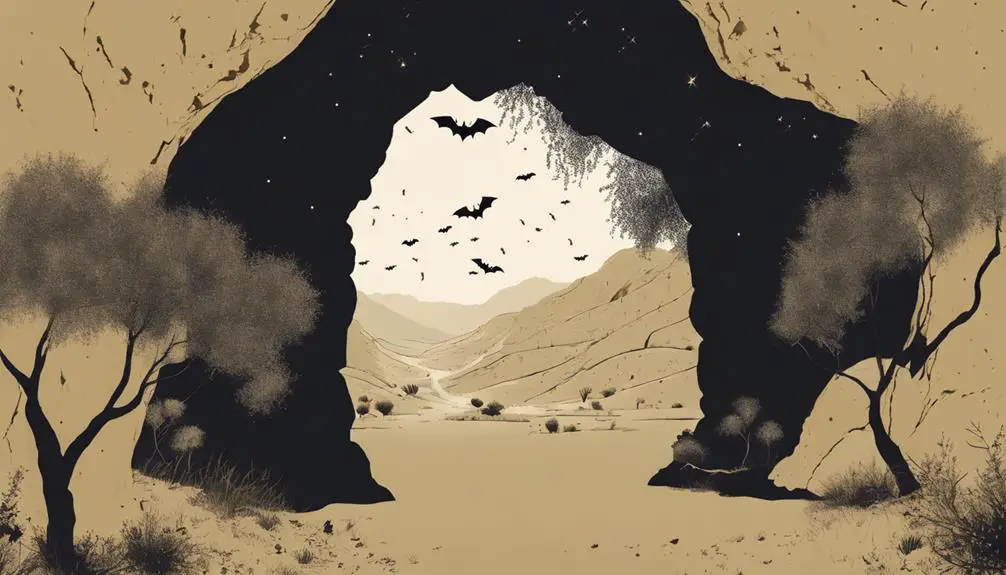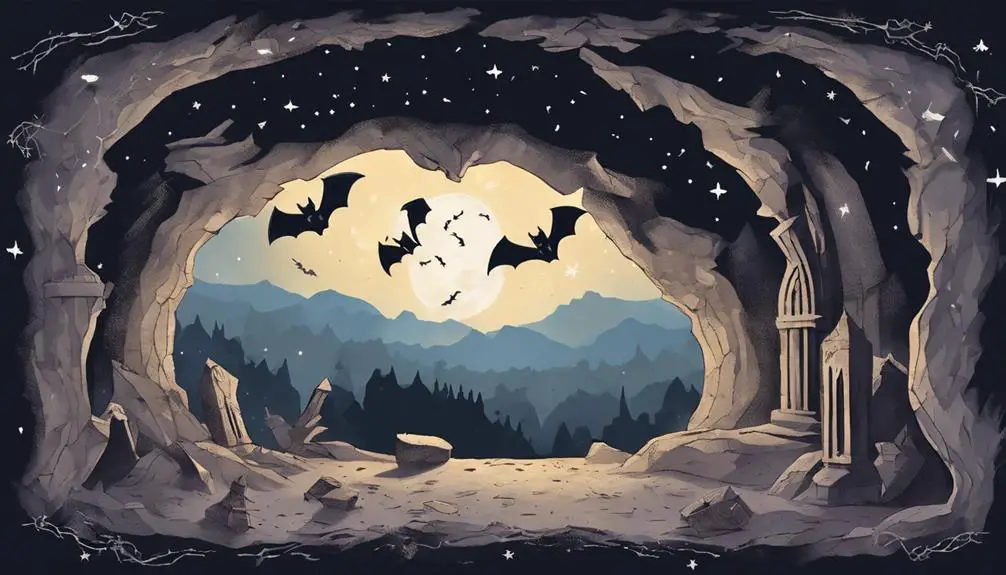Amidst ancient scriptures, bats emerge as enigmatic symbols of purity and sin, inviting a deeper exploration of their biblical significance.

Bats in the Bible
As you navigate the ancient texts of the Bible, bats flutter in the margins, often overlooked yet intriguing in their presence. You'll find that these creatures, nestled within the pages of Leviticus and Deuteronomy, carry a weight of symbolism and cultural interpretations far beyond their fleeting mentions.
They serve as a bridge between the unclean and the pure, challenging us to ponder their role in biblical history and theology. Exploring their significance sheds light on broader themes of purity, sin, and redemption throughout the scriptures.
Let's embark on this journey together, where you'll uncover layers of meaning that might just change the way you view these nocturnal beings and their place in biblical lore.
Key Takeaways
- Bats are depicted as unclean animals in Leviticus and Deuteronomy, reflecting ancient views on purity.
- Biblical references to bats symbolize estrangement and mystery, intertwined with nocturnal imagery.
- Cultural and spiritual interpretations of bats have evolved, influenced by their biblical portrayal as symbols of darkness.
- Modern scholarship encourages reevaluation of bats in biblical texts, advocating for contextually grounded understandings.
Historical Context of Bats

Bats have been entwined with human societies for millennia, often carrying rich symbolic and mythological significance across various cultures. You'll find that the historical context of bats is as diverse as the species themselves. With over 1,400 bat species, these creatures have fluttered through the annals of human history, leaving traces of their existence and interactions with people in various forms of archaeological evidence.
Digging into the past, you'd discover that bats haven't only been subjects of fascination but also of reverence and fear, depending on the geographical and cultural contexts. Archaeological evidence, such as cave paintings, artifacts, and even mummified remains, provides a window into how ancient civilizations perceived these nocturnal beings. This evidence suggests that bats were recognized in many societies long before their mention in religious texts, including the Bible.
Analyzing these findings, it becomes clear that the relationship between humans and bats is complex. It's shaped by ecological roles bats play in environments around the world and by the symbolic meanings attributed to them. These creatures, often misunderstood, have been pivotal in the development of cultural narratives, influencing how they're represented in religious and mythological texts.
Biblical References Explained
In the Bible, bats are mentioned in a context that sheds light on ancient perceptions and cultural attitudes toward these creatures. The references are sparse but significant, often intertwined with Levitical laws that delineate clean and unclean animals. Through these mentions, one can discern a complex relationship between humans and bats, mediated by religious, cultural, and practical considerations.
When you delve into the biblical text, you'll find:
- Bats are listed among the unclean animals in Leviticus 11:19 and Deuteronomy 14:18, which implies they weren't to be consumed by the Israelites. This classification underlines the Levitical laws' role in guiding daily life and spiritual purity.
- The nocturnal imagery associated with bats in Isaiah 2:20 suggests a symbolic use, where bats represent entities or practices to be discarded in times of renewal and purity.
- This imagery not only reflects the ancient understanding of bats but also incorporates them into a broader theological narrative about purity, impurity, and transformation.
These references, while brief, offer a window into how bats were perceived within the biblical world—viewed through lenses of both practical daily living and symbolic spiritual meaning.
Symbolism and Interpretations

Exploring the symbolism and interpretations of bats in biblical texts reveals deeper layers of meaning that go beyond their physical description as unclean animals. When you delve into the historical and cultural context, bats emerge not just as creatures of the night but as symbols carrying significant spiritual weight. Their presence in dreams and artistic depictions often straddles the realms of the sacred and the profane, embodying themes of renewal, death, and rebirth.
Aspect |
Interpretation |
Emotion Evoked |
|---|---|---|
Unclean Status |
Estrangement from the sacred |
Discomfort |
Nighttime Activity |
Mystery, unseen forces, intuition |
Intrigue |
Dream Interpretations |
Messages from the subconscious or divine |
Wonder |
Artistic Depictions |
Cultural ambivalence towards the spiritual realm |
Mixed Feelings |
Such symbolism invites you to ponder the multifaceted roles bats have played in human consciousness. While their unclean status might evoke discomfort, their portrayal in dreams and art suggests a deeper, more complex interaction with the divine and the mysterious aspects of life. Understanding these interpretations allows you to appreciate the rich tapestry of meanings bats contribute to the biblical narrative, transcending simplistic categorizations.
Cultural Impact of Biblical Bats
Throughout history, biblical references to bats have significantly influenced cultural perceptions and attitudes, shaping how societies across ages have viewed these enigmatic creatures. The Bible's mention of bats, albeit brief, has left an indelible mark on how they're perceived, intertwining religious texts with cultural narratives and artistic interpretations.
This impact is evident in several key areas:
- Artistic Depictions: Bats have often been portrayed in religious art as symbols of darkness or impurity, reflecting their biblical association with unclean animals. This imagery has permeated into medieval and Renaissance art, reinforcing the negative connotations associated with these creatures.
- Folklore Associations: The biblical view of bats as creatures of the night has seamlessly blended into various folklore traditions around the world. In some cultures, bats are associated with witchcraft, vampires, and other supernatural elements, underscoring their perceived mysterious and malevolent nature.
- Literary Motifs: Writers have frequently drawn upon the biblical portrayal of bats to symbolize or hint at themes of desolation, fear, and the unknown, showcasing the profound impact these references have had on literary traditions.
Modern Perspectives on Biblical Passages

Modern interpretations of biblical passages regarding bats reveal a shift towards understanding these references within their historical and cultural contexts, challenging previous perceptions of impurity and darkness. Scholars now recognize the complexity of translation challenges, which have historically contributed to misconceptions about bats. Ancient texts, when translated into contemporary languages, often carry the burden of cultural biases. You see, the original Hebrew terms and contexts were grounded in a specific time and place, making accurate translations without contemporary prejudices a formidable task.
This scholarly pivot emphasizes ethical considerations, urging a reevaluation of how animals, particularly bats, are represented and regarded in religious texts. It's not just about correcting past misinterpretations; it's about fostering a more inclusive and respectful dialogue between ancient texts and modern ethical standards. You're invited to consider how language and cultural shifts influence our understanding of the natural world within a biblical framework. This approach doesn't just enlighten readers about bats in the Bible; it opens up a broader conversation about the intersection of faith, ethics, and the natural world.
Through this lens, you're encouraged to explore the richness and complexity of biblical texts with fresh eyes, appreciating the nuances lost in earlier translations.
Frequently Asked Questions
How Do Contemporary Wildlife Conservation Efforts Relate to the Biblical Portrayal of Bats?
You're exploring how modern conservation efforts intersect with bat symbolism, without diving into biblical references. Bat symbolism often reflects misunderstood creatures needing protection.
Today's conservation techniques emphasize safeguarding these species, mirroring the symbolic need for understanding and protection. This alignment suggests a deeper, perhaps intrinsic value of bats, underlining the importance of contemporary conservation methods.
Such efforts are crucial for their survival, highlighting a shift towards appreciating the symbolic and ecological significance of bats.
Are There Any Specific Health or Medical Practices Related to Bats Mentioned in the Bible That Are Still Relevant or Practiced Today?
In the vast expanse of modern medicine, you won't find bat diets or practices directly plucked from ancient texts lighting our paths.
Yet, analyzing the current question through a scholarly lens reveals no specific health or medical practices related to bats mentioned in timeless scriptures that hold water in today's practices.
This observation isn't just a casual glance but a deep dive into how historical perspectives shape, or rather, don't shape, our contemporary medical approaches.
What Are the Linguistic Variations and Translations of the Word "Bat" in Ancient Biblical Texts, and How Have They Influenced Modern Interpretations?
You're navigating through translation challenges and cultural perceptions when exploring linguistic variations of the word 'bat' in ancient texts. These variations significantly influence modern interpretations, revealing how language evolution and differing cultural views shape our understanding today.
Can We Find Any Parallels or Significant Differences in the Depiction of Bats Between the Bible and Other Ancient Religious or Mythological Texts?
You're exploring how bats are depicted across ancient texts, focusing on mythological parallels and bat symbolism.
It's fascinating to see how these creatures are represented differently or similarly in various cultures. By comparing these depictions, you'll uncover a rich tapestry of beliefs and attitudes towards bats.
This analysis allows you to grasp not just the symbolic significance of bats but also how cultural contexts shape our understanding of these enigmatic creatures.
How Have Artistic Representations of Bats Influenced by the Bible Evolved Through Different Historical Periods, Especially During the Renaissance and Gothic Eras?
You've seen bats flit through the night, but have you considered their journey through art history?
Their evolution in artistic representation, especially during the Renaissance and Gothic eras, showcases a fascinating transition.
Renaissance artistry often embraced a more naturalistic portrayal, while Gothic symbolism imbued them with darker, more mysterious connotations.
This shift reflects broader cultural attitudes towards these creatures, illustrating how they've been both revered and reviled across time.
Conclusion
In sum, bats in the Bible have fluttered through the ages, encapsulating more than mere mentions—they symbolize impurity and are subjects of divine commands. These nocturnal creatures have cast long shadows over cultural and theological interpretations, evolving under the scrutinizing gaze of modern scholarship.
Peeling back layers of historical context and symbolism reveals that biblical references to bats aren't just about animals but about how purity, identity, and morality are woven into the fabric of faith. As the saying goes, 'the devil is in the details,' and indeed, examining the role of bats in biblical texts offers profound insights into the intricate tapestry of religious discourse.



Sign up